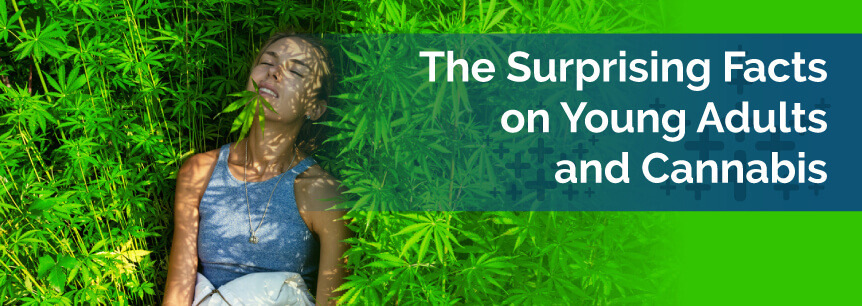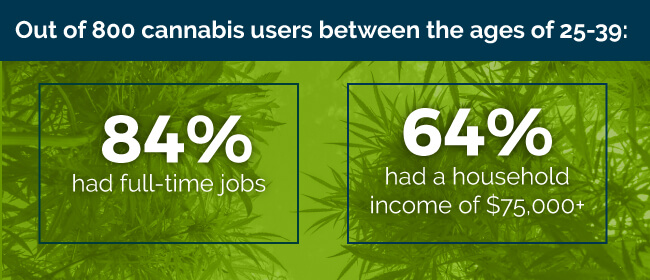
Many critics of legalized marijuana base a great deal of their opposition on the belief that most young people would abuse weed to the point where all they want to do is get high. But the facts paint a very different picture. Surveys and studies show that the majority of young adults who use cannabis lead active and productive lives.
The market research firm Miner & Co. conducted a survey in 2016 involving 800 cannabis users between the ages of 25 and 39 who live in California, Colorado and Washington — states where recreational marijuana was been legalized in recent years. More than 90 percent of them said they consumed weed at least one time a week, and 95 percent of them said they use it because it helps them stay focused and mindful rather than simply “stoned.”
The firm’s report on the study noted that cannabis has become an important part of users’ overall wellness programs, along with diet and exercise.

The vast majority of the survey respondents — 84 percent — said they had full-time jobs and 64 percent said their household income was $75,000 or more. A sizeable number of respondents — 42 percent — said they had at least one child.
A study published in the medical journal The Lancet Psychiatry reported that adolescent use of marijuana remained largely unchanged in the states where medicinal cannabis is legal. Data from more than one million teenagers gathered over nearly a quarter of a century showed there is no evidence they use more weed just because they live in a state that allows medical marijuana.
The study focused on use among young people between the ages of 13 and 18 during the 1991 to 2014 time period. These results supported a 2012 study conducted by California researchers that showed teens in the state actually used marijuana less often than before medical weed became legal.
There are other studies that show teen use of marijuana has largely remained unchanged in states where pot was made legal for recreational use. The Colorado Department of Public Health and Environment analyzed usage data in 2009, before weed became legal, and 2015 — three years after legalization occurred. The data showed that 21 percent of Colorado teenagers had used pot within the previous 30 days, compared to 25 percent who had done so in 2009. The department collected its data through surveys completed by approximately 17,000 middle and high school students throughout the state.
These numbers go a long way toward proving that the fears surrounding legal pot are very much unfounded. Colorado teens not only haven’t started smoking weed in droves now that it’s legal, but use has actually dropped.
But that doesn’t mean opponents won’t conduct their own surveys in an effort to prove their point. The anti-legalization group Smart Approaches to Marijuana pointed to other surveys that showed weed use among Colorado teens is actually among the highest in the U.S. But those surveys were based on responses from fewer than 400 teenagers, while the other was based on responses from nearly 20,000. The larger the sample, the more reliable the data will be.
The same group cited another report published by the University of Michigan in 2015. This report showed that access to marijuana has increased over the last 40-plus years. It showed that approximately 81 percent of teens in 1975 said they could easily find weed, while 90 percent said they could do so in 2014. But being able to find weed and actually using it are two completely different things.
A growing amount of research is showing that use among young people in states where medical cannabis is legal has not increased. Hopefully, this research will help convince leaders to either allow patients suffering from severe illnesses access to cannabis, or to expand that access. Far too many states either don’t allow people to legally possess weed for medicinal use, or have such restrictive programs that access is nearly impossible for most patients.
There are a lot of states that have legalized medicinal marijuana, but these “programs,” in many instances, are simply unworkable. For example, Texas is one of several states that allow patients to use cannabidiol (CBD) oil, an extract of the marijuana plant. But it severely restricts access. Only patients suffering from severe epilepsy can legally possess CBD oil, while the vast majority of patients dealing with other serious illnesses are completely shut out.
Another problem is that many states that allow CBD use don’t have in-state access. Patients have to travel out of state — in many cases, having to basically go across the country — in order to get the medicine they need to find relief from their symptoms. Even when they get back home, they still have to worry about whether or not they’ll be harassed by law enforcement officials.
Hopefully, statistics will help change the minds of state legislators and they will ultimately realize that legalizing medical marijuana won’t unleash the torrent of evils they fear. Making marijuana legal — for recreational or medicinal purposes or both — doesn’t automatically mean young people will turn to weed in droves.
Facts like these are going a long way toward helping to overcome the stereotype of cannabis users as being lazy, unmotivated stoners. It’s time for the conception of marijuana use to evolve, and for more people to realize that just because someone smokes a joint, that doesn’t mean they can’t be productive and vital members of society.
At MarijuanaDoctors.com, we firmly believe that everyone who is suffering on a daily basis from a severe illness should have access to medical cannabis if they choose. We are continually monitoring developments across the country and we hope that the growing body of evidence will help convince those opposed to medical marijuana that they should make it available to anyone who needs it.
No Information on MarijuanaDoctors.Com should be used to diagnose, treat, prevent or cure any disease or condition. You can view our Full Disclaimer here.